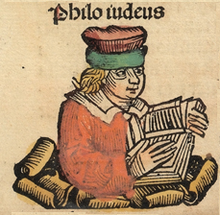7 November. What did John mean by the 'Word' or 'Logos' of God?
"We write to you now about what has always existed, which we have heard, we have seen with our own eyes, we have looked at, and we have touched with our hands."
"We write to you about the 'Word' (Greek - 'logos') that gives life. He who gives life was shown to us. We saw him and can give proof about it."
"And now we announce to you that he has life that continues for ever. He was with God the Father and was shown to us."
"We announce to you what we have seen and heard, because we want you also to have fellowship with us. Our fellowship is with God the Father and with his Son, Jesus Christ."
"We write this to you so you can be full of joy with us."
(1 John 1:1-4)

At the beginning of his First Letter, John wrote about Jesus Christ, the Son of God, “the Word that gives life” (1 John 1:1).
With God the Father, he existed from the beginning of time. Although divine, and the very source of eternal life, he became fully human and was seen and touched by John.
When John refers to Jesus as the ‘word’ of life, this is almost identical to the beginning of John’s own Gospel, where he calls Jesus the ‘word’ of God (see John 1:1).
In both cases, the Greek word that is usually translated as ‘word’ is ‘logos’. But what does it really mean?
Although ‘logos’ can mean a ‘word’ in a different context, this is not the real meaning of ‘logos’ as used here by John. The word ‘logos’ is, in fact, a technical term from Greek and Jewish philosophy that was well known at the time John was writing. It was a philosophical term used to describe the latest 1st century ‘scientific’ explanation of how the world had come into being at the time of creation.
The term ‘logos’ was first used by the Greek philosopher Heraclitus, who lived in Ephesus (where John was based) about 500 years before Jesus. He used the term to indicate the principle of order that made all the difference at ‘creation’ between ‘chaos’ (which was always there) and the ordered universe as we know it.
The idea of the ‘logos’ gradually developed over the next 500 years. The ‘Stoic’ philosophers with whom Paul debated at the Areopagus on Mars Hill in Athens (see Acts 17:18) identified the ‘logos’ with the 'reason' or ‘divine animating principle' pervading the universe and causing the world to function in an ordered way.
The idea was developed further in the 1st century AD by the Jewish philosopher Philo of Alexandria, who adopted the term in Jewish religious philosophy to mean ‘an intermediary divine being’. In Philo’s philosophy – well known to John’s 1st century Jewish readers – the ‘logos’ was recognised as the highest of these intermediary beings. Philo even went as far as calling the ‘logos’ the ‘first-born of God’.
In his Gospel (and in his First Letter), John says that, not only was Jesus present with God at the beginning of creation; not only was he the 'logos' controlling the universe as described by Philo; but Jesus was actually God himself – and the source of all creation (see John 1:1-3).
He goes on later in his Gospel's opening chapter to declare that the ‘logos’ became flesh – was born as a human being, Jesus of Nazareth, who was also the expected Jewish Messiah (or 'Christ') and “the Lamb of God who takes away the sins of the world” (see John 1:14-29).
The photo shows a depiction of Philo of Alexandria, the Jewish philosopher, who described the 'logos' as the 'first-born of God' (from Die Schedelsche Weitchronik).
You can read more about the 'logos of God' @ The Bible Journey | The 'logos' of God
